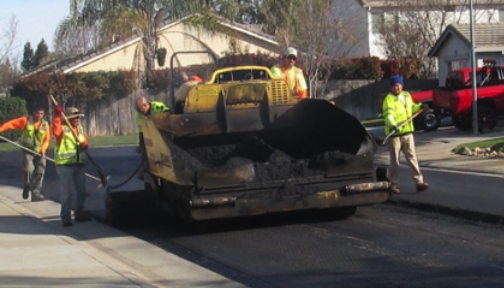Opening the Keys of Warm Mix Asphalt Technology
Discovering the midsts of hot mix asphalt modern technology reveals a world where meticulous procedures and accurate formulations merge to shape our roadways and facilities. The fusion of fillers, accumulations, and binders isn't just a building task however a tactical orchestration of resilience and efficiency.
Value of Hot Mix Asphalt
Warm Mix Asphalt plays an important role in modern-day infrastructure advancement due to its sturdiness and cost-effectiveness. As one of the most typically used leading material for roads, highways, and parking great deals, Warm Mix Asphalt uses a variety of benefits that add to its relevance in building tasks. One key advantage is its capacity to withstand rush hour loads and severe climate conditions, offering a reputable and durable surface for transportation networks. In Addition, Warm Mix Asphalt is cost-effective in both initial building and long-lasting upkeep, making it a recommended choice for numerous facilities jobs.
The sturdiness of Warm Mix Asphalt originates from its make-up, which consists of accumulations, binder, and filler products that are meticulously selected and blended to fulfill details efficiency requirements. This accurate combination results in a strong and flexible sidewalk that can sustain constant use without significant wear and tear. Warm Mix Asphalt is 100% recyclable, more boosting its sustainability and ecological advantages. Overall, the significance of Warm Mix Asphalt in facilities growth can not be downplayed, as it remains to be a cornerstone of modern-day building and construction techniques.
Parts of Asphalt Mixes
The structure of asphalt blends is composed of carefully selected aggregates, binder, and filler products that are critical for achieving particular efficiency needs. Accumulations are the key component of asphalt mixes, offering stamina and security. The binder, commonly bitumen or asphalt cement, holds the aggregates together and offers versatility and longevity to the mix.
The mix and percentage of these components play a significant role in identifying the high quality and performance of the asphalt mix. Engineers thoroughly develop the mix to satisfy particular demands, thinking about elements like web traffic volume, climate conditions, and pavement life-span. Proper option and harmonizing of accumulations, binder, and fillers are necessary for developing long lasting, resilient asphalt pavements.
Mixing and Production Techniques

Once the aggregates are selected, the binder, typically asphalt cement, is added to bind the materials together. The binder's high quality and amount substantially influence the mix's resistance, adaptability, and toughness to ecological factors. Additionally, fillers like hydrated lime or Rose city concrete might be integrated to improve particular attributes of the asphalt mix, such as its workability or dampness resistance.
During production, the aggregates and binder are heated, typically between 250-325 Bonuses ° F(121-163 ° C ), to promote blending and make sure proper coating of the accumulations. The mixing process has to be complete to accomplish a homogeneous combination that advertises the preferred performance qualities of the asphalt. Various strategies, such as set mixing or drum blending, are utilized to achieve regular and top notch asphalt mixes for building and construction jobs.
Factors Influencing Asphalt Performance
Factors affecting asphalt performance incorporate an array of variables that influence the longevity, durability, and general quality of asphalt pavements. One vital factor is the top quality of materials used in the asphalt mix. The type and resource of accumulations, the binder high quality, and the additives all play a significant function in identifying the performance of the asphalt sidewalk. The rank of accumulations is vital as it impacts the mix's security, workability, and resistance to breaking and rutting.

Ecological visit this website conditions additionally influence asphalt efficiency. Temperature variants, moisture seepage, and traffic lots can all impact the architectural stability of the sidewalk. Style considerations, such as sidewalk thickness and water drainage, are vital in ensuring the long-lasting performance of the asphalt pavement. By meticulously thinking about these engineers, aspects and contractors can maximize asphalt performance and enhance the life explanation span of sidewalks.
Lasting Practices in Asphalt Technology
:max_bytes(150000):strip_icc()/asphalt-worker-134249388-58cdf96f5f9b581d723f2f33.jpg)
Furthermore, the development of warm-mix asphalt (WMA) technologies has obtained grip in recent times. WMA enables the production and placement of asphalt blends at reduced temperature levels compared to traditional hot-mix asphalt, resulting in lowered power usage and greenhouse gas discharges. The usage of porous asphalt blends can aid reduce stormwater runoff issues by enabling water to infiltrate via the pavement and into the ground, advertising natural water filtration and reenergize processes. By applying these lasting practices, the asphalt sector can add to building an extra ecologically pleasant and durable infrastructure network.
Final Thought
To conclude, hot mix asphalt innovation plays a critical duty in modern infrastructure advancement because of its durability and cost-effectiveness. By thoroughly balancing elements, using correct blending strategies, and considering various elements, engineers can produce top notch asphalt blends that hold up against rush hour lots and rough weather conditions. Welcoming lasting techniques, such as using warm-mix modern technologies and recycled products, better boosts the ecological kindness of asphalt modern technology.
Mixing and manufacturing techniques in warm mix asphalt modern technology include the accurate combination and handling of accumulations, binder, and fillers to produce a resilient and high-performance asphalt mix.Elements influencing asphalt efficiency incorporate a variety of variables that affect the sturdiness, longevity, and overall quality of asphalt sidewalks. Sustainable practices in asphalt technology encompass numerous campaigns aimed at reducing the ecological effect of asphalt production and paving procedures. By integrating reclaimed asphalt sidewalk (RAP) and recycled asphalt tiles (RAS) right into new asphalt blends, the market can considerably lower the usage of raw products and energy, while also lowering land fill waste.
WMA enables for the production and positioning of asphalt mixes at reduced temperature levels compared to typical hot-mix asphalt, resulting in minimized energy usage and greenhouse gas discharges.
 Amanda Bearse Then & Now!
Amanda Bearse Then & Now! Kenan Thompson Then & Now!
Kenan Thompson Then & Now! Danielle Fishel Then & Now!
Danielle Fishel Then & Now! Kane Then & Now!
Kane Then & Now! Heather Locklear Then & Now!
Heather Locklear Then & Now!